What were they? The dead were evasive when asked, and appeared uneasy with the topic. The Headmistress, in one of those intuitive leaps so characteristic of her, decided that they were another form of haunted speech, were in fact words—or, possibly, whole phrases—from an unknown language of the dead dead. This revelation was to transform her earlier notions, for if the dead also die, that is, pass from their own plane into a yet deeper realm of death, then death and life are not opposites, pressed together like two palms in prayer, but graduations in a series. Thus it was the mouth objects that supplied the first and best clue to the complex structure of the necrocosmos. Yet in many ways they remain as great a mystery as when they were first documented.
These corpses or mummies of words are translucent, waxen in appearance, gummy but firm in texture, and something between animal or vegetable in form, so that they really appear not modeled by conscious art but grown. The production of mouth objects is rarely witnessed, but we are lucky to have a description in the Headmistress’s own hand of a “stirring” in the throat of a sleeper, then an “intricate rippling, gathering, pleating, and revolving.” She wonders whether this “kneading” by the deep muscles of the throat, muscles rarely subject to our conscious control, is precisely what shapes the mummified voices of the dead, imposing form on something itself formless, or whether the words materialized in the throat fully formed, and the activity observed there was merely a sort of peristalsis, moving the objects forward. With her usual perspicacity she has hit on exactly the point of contention that rocks lecture halls today; science has not advanced one inch since her time.
In a magnified slice of a mouth object, you can see the reticulated structures reminiscent of honeycomb tripe, or cow stomach, that early researchers described, and that strengthen the claim that these objects are not merely excretions or accretions of matter, like ambergris in a sperm whale’s intestines, but are three-dimensional hieroglyphs, somewhat crushed and distorted, perhaps, but still displaying the distinguishing features by which they would communicate to a viewer possessed of their secrets.
Incidentally, the widely circulated report that in one mouth object researchers found a baby tooth and some coiled hair is almost certainly apocryphal, inspired by those teratomas in which a sort of anagram of a baby seems to be trying to get itself born. (If true, however, it would suggest that teratomas and perhaps all tumors are special dispatches from the dead. It is not actually such a far-fetched notion: We all carry messages from our forebears, scrolled neatly in our cells. Indeed we are those messages. But I digress.)
It is regrettable that some of the best-known depictions of mouth objects are the work of J. T. Giesel, once a highly respected researcher, but since fallen out of favor for the degree to which wishful thinking (if not the deliberate intention to deceive) colored his imaginative depictions of the mouth objects. In his rendering, the lumpen and even—why not admit it?—rather fecal word has acquired a delicate tensile strength, like a bridge. He is right, in one sense: The word is a bridge to the world of the dead—or to, I should say, another world of the dead. However, I think we should not so readily dismiss what is intimate, personal, and a little disgusting about mouth objects. As with most things that come out of the human mouth, hot with breath or wet with saliva, we are uncomfortable with them. They seem unclean, or overly revealing, or both. Perhaps they are also attractive in a way that threatens certain boundaries we have learned to maintain. Only what we call speech is exempt from this prejudice; we listen publicly to others’ words without a blush and even take them into our own mouths in mimicry or quotation. We have learned to unbuckle language from the gag reflex. It is our loss. The word is personal, comes from flesh and returns there. The mouth object restores its natural grime to language. Here, from the archives of the Vocational School, in an unknown hand, are some images of mouth objects over which no prettifying veil has been drawn.
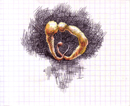 | 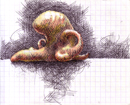 |  |
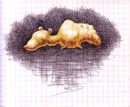 | 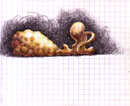 | 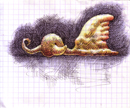 |
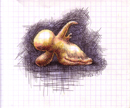 |  | 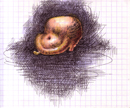 |
It is now pretty generally accepted that these objects are indeed elements of a language of the dead. There is only one rival theory worth mentioning, that they are made up of a sediment or “fallout” shed by our own almost but not entirely immaterial words in their passing, which builds up on irregularities in our larynx, lungs, or vocal cords, until it is sloughed off or perhaps forcibly ejected. The peculiarities in form are explained—inadequately, many feel—as the progressive exaggeration of purely accidental variations in form; the idea is that any slight protrusion will tend to attract more of this sediment than a depression, so that over time these features will become more pronounced. Of course, even if this theory is true, these accretions might still have an unrecognized semiotic aspect, might still be attributable to the dead.
But many questions remain to be answered. We do not even know whether we perceive them in their original form, as elements of a language entirely based on the exchange of solid objects, and if so whether these objects are the three-dimensional equivalent of logograms, in which representational elements can be made out in radically simplified form, as in the Japanese kanji; or are made up of alphabetic elements; or whether, like the learned professors of Swift’s Grand Academy of Lagado, the dead are carrying on conversations by means of objects that signify only themselves. In which case the task before us is not to determine what they mean but to see what they are. It is no mean one.
On the other hand, it may be that signal corruption alters the once limpid word as it passes through successive regions of the dead. Perhaps a sort of Doppler effect shifts the word farther along a spectrum of thingliness, as it moves deeper into death. Certainly five- or six-dimensional words would have to undergo a process of translation to manifest in any meaningful way in our world. (For a lucid treatment of the relationship of the various levels of the necrocosmos to the spatiotemporal dimensions, please see Klein’s Necrocosmos, particularly chapters 2 and 5.) Or perhaps they are a sort of pidgin, having been deliberately yet clumsily endowed with physical properties in order to establish rapport with a world where material objects are held in high esteem.
If so, they have largely failed, though it is true that students have found that some of these objects name new feelings for them, new thoughts, which once conceived cannot be described in other words. Only a sketch of the shape will convey the approximate meaning, and only the object itself will be truly eloquent. But an understanding of the whole language has so far eluded us. Scholars are cataloguing new words as they appear, in the hopes of discovering patterns that will unlock this language for the living. I would like to call all thanatomaths and interested amateurs to the work of translating these messages into English. Alternatively, some may wish to translate these objects into other material objects native to our world. I would also like assistance in translating our own language(s) into physical objects. Perhaps we can reply to these strange bulletins from the “dead dead,” if we learn their language.
Or do we already know it? The mouth objects suggest that the relatively ethereal dead die into a more thingly state, a state analogous to our own. But maybe it is our own, just viewed from the other side, as it were. From this idea, not very clear, but attractive in its economy, arose the several elegant and complex models of the necrocosmos that the Headmistress was to develop in the months before (and, via spirit transmission, the many years after) her death. For a full discussion of the linear model, the cyclical model, and various rival theories please see, again, Klein’s Necrocosmos.
Thus, it is possible that our entire physical universe is composed of the speech of the dead, to which, alas, we are deaf. Believing this to be true, the Headmistress concentrated all her considerable powers on developing new ways of listening. (“My whole body has become an ear,” she wrote.) Though she never succeeded in translating to her satisfaction either the mouth objects or any of the objects native to our world on which she bent her attention (including, according to former student Clive Matty, antlers, hair, her own sputum, and insect carapaces), she remained carefully optimistic. “It may be that we already speak this language,” she wrote, “albeit not with our mouths.” After all, we too are material objects, ambiguously and temporarily haunted by voices. Able morticians and undertakers, we groom our corpses, daub blush on our cheeks, pink the lips. We look alive, but only for a little while.
The Headmistress performed several experiments on the objects: immersing them in water, then in distilled alcohol, heating and cooling them, rubbing them with wool, striking them with mallets. One word was given to a terrier to sniff, who was moved to urinate, another shown to an infant, who recoiled. One was allowed to air-dry until hard, ground fine, and mixed with ink. A greasy elastic film formed on the surface of this solution, which the nib had some trouble piercing. The ink had the tendency to draw itself up into balls on the surface of the page and, when the paper was lifted, to roll away, leaving the paper perfectly blank in places. (This may be no more than a curiosity, but the portions of the text that vanished composed, without exception, pronomial forms and proper names.)
Her account of one early experiment is worth quoting in full, and will conclude this brief report. “This evening I conducted tests on one of the words, though to destroy it seemed to me like savaging my own tongue. I first laid it on a glass tile I had wiped with rubbing alcohol. With a clean, very sharp knife I sliced it first longitudinally, then latitudinally. I winced as the blade passed through the substance, which clung to it. I had to bring down the knife very slowly so as not to distort the word in slicing it. I observed that the cross section revealed minute whorls and fault lines where the substance was whiter and more opaque, like wax that has been put under pressure. One part of the word I picked up with a pair of tongs and held over a low flame. This experiment was exceedingly distressing to me. I noticed with interest an increase in salivation; my mouth was flooded with sweet water. It would be interesting to try to determine whether this empathetic response is characteristic of all subjects. The flame took all over the surface of the word, igniting with a soft pop. The flame very bright and mellow. The lump shrunk without spattering or bubbling. I deduce from this that its substance is dense and pure. The effect was not unlike burning a candle of very fine wax, but brighter. As the word shrunk it performed several revolutions or convulsions too quick to follow with the eyes but disturbing and uncanny, especially as it seemed to me that it passed through several forms that were recognizable and possibly of particular personal significance, though due to the rapidity of transformation I could not get my head around the business of recognizing them. Later I would try to draw my impressions of the intermediate positions I had glimpsed and find it impossible.
“The last consumption of the final morsel happened very quickly, as if with a sudden leap of joy, and the word disappeared. As it did so it emitted a sound that is hard to describe. It might have been a very high pitched or very fast declaration. It seemed to contain many sounds, though it was over in no more than an instant.
“If I could hear that sound again, it seems to me I would understand everything that is now obscure to me. But perhaps I should not strain, through an act of violence, to translate dead matter into sense. When I myself am dead matter, I will speak the language of things. Then at last I will understand what it is that the world has been trying to tell me, all my life.”
Topics for further study:
If these objects are indeed words (and not letters, or sentences, as others have proposed), what parts of speech are they? How are they conjugated, declined; what rules govern their arrangement?
Do they represent just one language, or a babel?
Could the physical laws of our universe be the grammar of the language of the dead?
Who is the speaker?
Who is the intended listener?
What would constitute listening to such a word? (Licking it? Rapping it against one’s head?)
Is there significance to the sequence in which they arrive in our world? Do they compose, taken together, a message? An SOS, broadcast into the necrocosmos, on the chance that someone is listening? Words overheard in a crowd? A story?